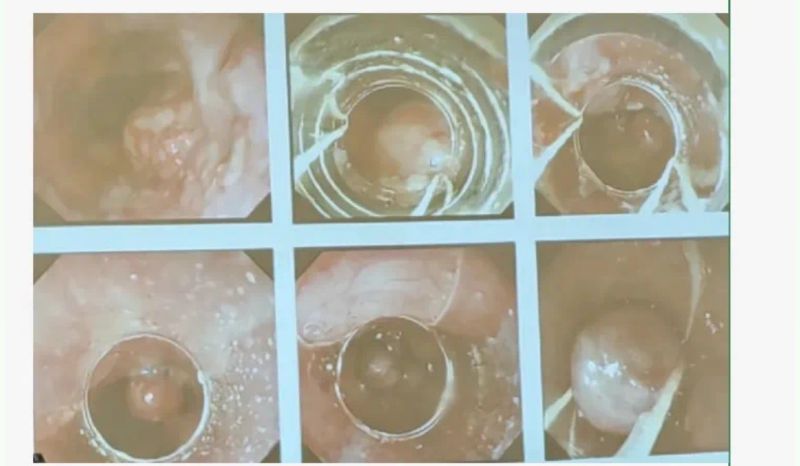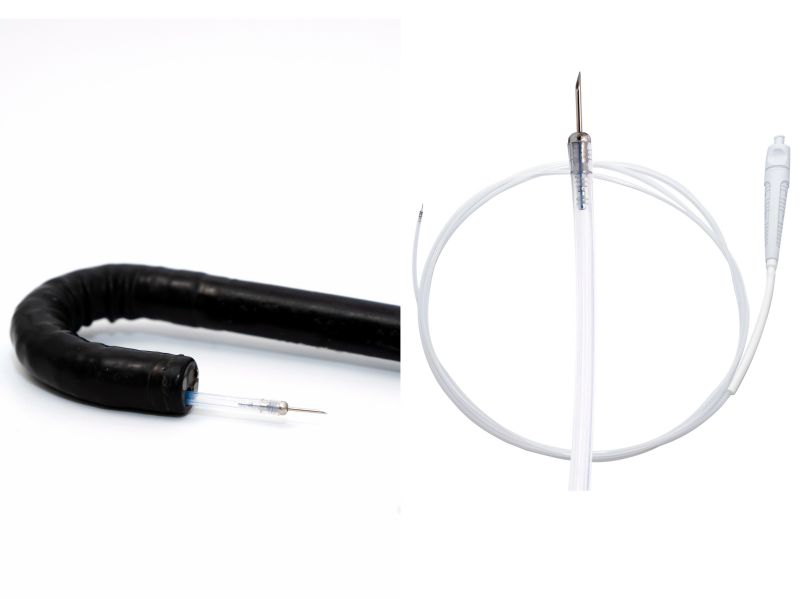1) Principle of endoscopic sclerotherapy (EVS):
Intravascular injection: sclerosing agent causes inflammation around the veins, hardens the blood vessels and blocks blood flow;
Paravascular injection: causes a sterile inflammatory reaction in the veins to cause thrombosis.
2)Indications of EVS:
(1) Acute EV rupture and bleeding;
(2) People with a history of EV rupture and bleeding; (3) People with recurrence of EV after surgery; (4) People who are not suitable for surgical treatment.
3) Contraindications of EVS:
(1) Same as gastroscopy;
(2) Hepatic encephalopathy stage 2 and above;
(3) Patients with severe liver and kidney dysfunction, large amounts of ascites, and severe jaundice.
4) Operation precautions
In China, you can choose lauromacrol. For larger blood vessels, choose intravascular injection. The injection volume is generally 10~15mL. For smaller blood vessels, you can choose paravascular injection. Try to avoid injecting at several different points on the same plane (possibly Ulcers may occur leading to esophageal stricture). If breathing is affected during the operation, a transparent cap can be added to the gastroscope. In foreign countries, a balloon is often added to the gastroscope. It is worth learning from.
5) Postoperative management of EVS
(1) Do not eat or drink for 8 hours after surgery and gradually resume liquid food;
(2) Use appropriate amounts of antibiotics to prevent infection; (3) Use drugs that lower portal pressure as appropriate.
6) EVS treatment course
Multiple sclerotherapy is required until the varicose veins disappear or basically disappear, with an interval of about 1 week between each treatment; gastroscopy will be reviewed 1 month, 3 months, 6 months, and 1 year after the end of the course of treatment.
7) Complications of EVS
(1) Common complications: ectopic embolism, esophageal ulcer, etc., and
It is easy to cause blood spurting or gushing blood from the needle hole when the needle is pulled out.
(2) Local complications: ulcers, bleeding, stenosis, esophageal motility dysfunction, odynophagia, lacerations. Regional complications include mediastinitis, perforation, pleural effusion, and portal hypertensive gastropathy with an increased risk of bleeding.
(3) Systemic complications: sepsis, aspiration pneumonia, hypoxia, spontaneous bacterial peritonitis, and portal vein thrombosis.
Endoscopic varicose vein ligation(EVL)
1)Indications for EVL: Same as EVS.
2) Contraindications of EVL:
(1) Same contraindications as gastroscopy;
(2) EV accompanied by obvious GV;
(3) accompanied by severe liver and kidney dysfunction, large amounts of ascites, jaundice
Gangrene and recent multiple sclerotherapy treatments or small varicose veins
Taking the Han Dynasty as a near-duofu means that the Hua people will be able to move freely, or the tendons and pulses will be stretched to the west.
By.
3)How to operate
Including single hair ligation, multiple hair ligation, and nylon rope ligation.
Principle: Block the blood flow of varicose veins and provide emergency hemostasis → venous thrombosis at the ligation site → tissue necrosis → fibrosis → disappearance of varicose veins.
(2) Precautions
For moderate to severe esophageal varices, each varicose vein is ligated in a spiral upward manner from bottom to top. The ligator should be as close as possible to the target ligation point of the varicose vein, so that each point is fully ligated and densely ligated. Try to cover each varicose vein at more than 3 points.

EVL steps
Source: Speaker PPT
It takes about 1 to 2 weeks for the necrosis to fall off after bandage necrosis. One week after the operation, local ulcers may cause massive bleeding, the skin band falls off, and mechanical cutting of varicose veins bleeds, etc.;
EVL can eradicate varicose veins quickly and has few complications, but the recurrence rate of varicose veins is high;
EVL can block the bleeding collaterals of the left gastric vein, esophageal vein, and vena cava, but after the esophageal venous blood flow is blocked, the gastric coronary vein and perigastric venous plexus will expand, the blood flow will increase, and the recurrence rate will increase over time, so it is often Repeated band ligation is required to consolidate the treatment. The diameter of varicose vein ligation should be less than 1.5cm.
4) Complications of EVL
(1) Massive bleeding due to local ulcers about 1 week after surgery;
(2) Intraoperative bleeding, loss of leather band, and bleeding caused by varicose veins;
(3) Infection.
5) Postoperative review of EVL
In the first year after EVL, liver and kidney function, B-ultrasound, blood routine, coagulation function, etc. should be reviewed every 3 to 6 months. Endoscopy should be reviewed every 3 months, and then every 0 to 12 months. 6) EVS vs EVL
Compared with sclerotherapy and ligation, the mortality and relapse rates of the two are
There is no significant difference in blood rate and for patients who require repeated treatments, band ligation is more commonly recommended. Band ligation and sclerotherapy are sometimes combined to improve the treatment effect. In foreign countries, fully covered metal stents are also used to stop bleeding.
The Sclerotherapy Needle from ZRHmed are used for Endoscopic Sclerotherapy (EVS) and Endoscopic varicose vein ligation(EVL).

Post time: Jan-08-2024


